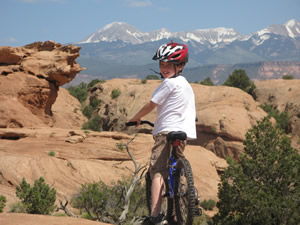
Spring in the Rockies a strange mix of sun, sand and snow
April 28, 2009 —
Is there anything worse than living in a ski town when the lifts shut down and the snow just keeps on coming?
Try escaping from that ski town to Utah’s canyon country in search of sun and finding instead blistering winds … and more snow.
I guess that wind is what formed all of those amazing rock spires, arches and natural bridges, but after 437 inches of snow this season at Vail, I wasn’t in the mood for any of the annual average of 10 inches of precipitation in Moab.
But for the second time in a about a month, the weather chased me and my posse out of southeastern Utah, following us home with a fine film of airborne sand.
It’s one thing to hunker down in a sandstorm camping with a 5-year-old and a 7-year-old, as I did last month, but another thing entirely when you have your 2-year-old along for the ride. You can only spend so much time in an enclosed space with Rennick.
My oldest son Nick and I got a couple of good mountain bike rides in on some decent single-track near our campground at Deadhorse Point, but then the heavens opened up, the wind started whipping and we headed home Sunday, a week after a classic closing day at Vail Mountain.
That previous weekend was even more snowy in Vail, where once again we closed with a powder weekend. But the final day was sunny and sizzling, and a good time was had by all. For the record, I closed out with Days 42, 43 and 44 – a personal triumph given my knee injury from a season ago. Might get Day 45 at A-Basin before it closes in June.
Speaking of last season, when we had 463 inches (bear in mind our average is 350) but I missed more than half of it due to injury, back-to-back amazing ski campaigns might lead one to believe global warming really is a myth. Fact is, it snowed a lot but never got too cold. So returning home early from camping Sunday allowed me to watch “60 Minutes” and get a little more perspective.
The CBS news mag aired an interesting primer on the debate over so-called “clean-coal technology,” interviewing some of the heavy hitters in the industry and scientists calling for a moratorium on all new coal-fired power plants.
Duke Energy CEO Jim Rogers acknowledged the urgency of slowing carbon emissions and dramatically reducing greenhouse gas emissions by the year 2050 – certainly a step in the right direction for the head of the third largest power provider in an industry that for years has fought to deny global warming.
But as the program pointed out, Duke has spent nothing on carbon-sequestration technology – basically injecting carbon emissions into underground reservoirs – and recently cut the ribbon on two new coal-fired plants.
The enviro blogosphere was largely underwhelmed by the piece, with earth2tech.com pointing out that the story failed to mention any of the companies such as PowerSpan or GreatPoint Energy that are doing truly groundbreaking research in the clean-energy arena.
Still, from a general-public perspective, the story should have served as major eye-opener. There needs to be much more mainstream reporting along these lines to educate people like the Intermountain Rural Electric Association board members and the rural co-op’s voters who backed the status quo last week, instead of choosing green candidates.
Or for that matter the proponents of using nuclear energy to power the oil shale industry on the Western Slope. How many truly “clean-coal-fired” power plants could be built for the billions it will take to get oil shale production up and running, with nuclear plants powering the industry to boot?
Meanwhile, China is building a carbon-belching, coal-fired plant a week. Develop the technology and maybe we could export something to China for a change, and keep our ski seasons from shrinking by a week or two a year for the next few decades.
![]() Comment on "Spring in the Rockies a strange mix of sun, sand and snow" using the form below
Comment on "Spring in the Rockies a strange mix of sun, sand and snow" using the form below












